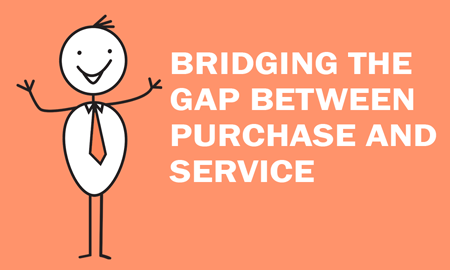Bridging the gap between purchase and service

For the majority of us, buying something that we really want gives us an emotional buzz. Whether it is a car, TV, clothes or even something as small as a book or new headphones, getting our hands on a new purchase makes us happy. Consequently, companies across all industries try extremely hard to make the buying process as simple, straightforward and engaging as possible. As we know, success can sometimes be difficult – we’ve all faced surly salespeople or online glitches on ecommerce sites, but organizations understand the impact of poor processes on their bottom line revenues.
However, a new study by Bruce Temkin of the Temkin Group shows that this focus on servicedoesn’t transfer across to subsequent customer service interactions. The research asked 10,000 consumers to rate their recent purchases and customer service interactions, based on a scale of 1 (upset) to 7 (delighted), across 11 different industries. It then calculated an average for each industry, based on subtracting the percentage of those that gave ratings of 1,2 or 3 from those that gave a 6 or 7.
The figures highlight some staggering gaps between purchase and service. Buying something, whatever the industry, provides a much more positive emotional response than interacting with customer service. The gap ranges from 11 points (health plans) to an enormous 49 (TV/internet service). Even those that score highly for emotional satisfaction in the purchase process, lose this goodwill when it comes to customer service. Buying a car is the perfect example. It scored the highest satisfaction rating (69%) for purchase, but just 34% for subsequent service. You can read the full results here at the Temkin Group site.
In my opinion, this failure to take a holistic view of post-sales service has two main causes:
1. Disconnected processes
In many organizations, sales and service are dealt with by separate departments, which could provide a less than seamless process for the customer. In some cases, customer service agents may not even be able to access the same IT systems or may have out of date customer records. Particular requests or information (such as don’t try and install my broadband on a Tuesday), may not be passed on, forcing customers to repeat themselves, adding to their frustrations.
2. Failure to think like a customer
This is linked to taking a departmental, rather than a holistic view of the customer and essentially means the company has not anticipated what a consumer will do post-purchase or the common issues they may have. Keeping with the TV/cable example, has the install/switchover process been explained clearly, including how they can get their service up and running? Ironing out bumps in the journey, such as by analyzing what consumers are calling your service desk about, should help redesign processes to make everything more seamless.
Whatever the cause, poor service has the potential to ruin the emotional engagement that the company has spent time and resources building around a sale. It damages the company’s reputation and means that the consumer is less likely to consider buying from them in the future, no matter how happy they were when they actually made the purchase. Customers are less likely to recommend a company, and may actively complain to friends, family and via social media. If they are buying something that could be purchased elsewhere, reset assured they won’t be shopping with you next time.
In many industries, service is becoming a bigger part of the transaction than the physical purchase. For example, many people don’t download music, but simply sign-up to a streaming service, or travel by the likes of Uber rather than invest in buying an automobile. Fail to provide strong, emotionally engaging service and customers will leave and switch to the competition. In other cases, auto dealers will make higher margins servicing a car on an ongoing basis than on the sale itself – poor customer service will cut off this revenue stream.
For all these reasons, companies need to bridge the disconnect between sales and service and ensure they have the resources in place to help customers get the most out of their purchase. By keeping engagement high, they’ll not only protect their reputation, but will help safeguard future revenues, benefiting the bottom line.







Comments